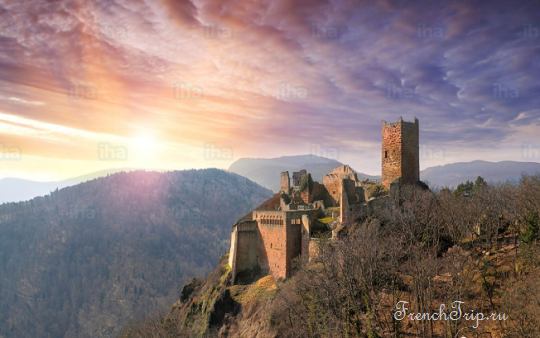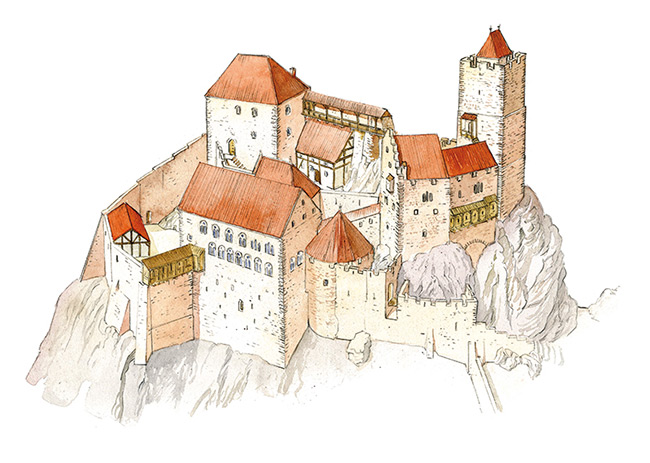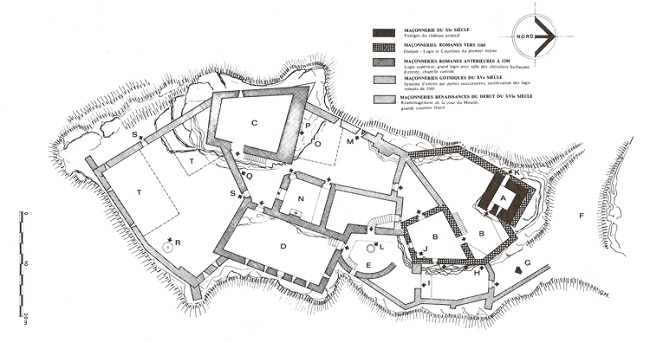Château du Saint-Ulrich (Ribeauvillé)
Château du Saint-Ulrich is one of the famous 3 castles of Ribeauvillé. It is located at an altitude of 528 m.

The current name of the site comes from the chapel dedicated to St. Ulrich of Augsburg, which is located in the castle. Medieval texts never gave the current name — the castle bore the name of the Rappolstein dynasty (or Ribopierre in the French).
The Château Saint-Ulrich has been listed as a historical monument by the French Ministry of Culture since 1841.
- Chateau du Haut-Ribeaupierre
- Chateau du Girsberg
- Chateau de Saint-Ulrich
- Château du Ribeauvillé or château Bas des Ribeaupierre
3 castles of Ribeauvillé
The three famous castles that overlook the medieval city of Ribeauvillé — Saint-Ulrich, Girsberg-Stein, and Haut-Ribeaupierre — are mentioned in a saying that dates back over three centuries:
“Three castles on a mountain (Ribeauvillé)
Three churches in an enclosure (Riquewihr)
Three towns in a valley (Ammerschwihr, Kaysersberg, Kientzheim)
That is all of Alsace.”
Among the four ruins dominating Ribeauvillé, Saint Ulrich stands out as one of the most fascinating castle complexes in Upper Alsace. It once controlled the strategic route connecting the Alsace plain with the upper Lièpvre valley. A testament to the power of the lords of Ribeaupierre, it served as their main residence until its final abandonment in the 16th century. It is therefore endowed with different architectural styles: Romanesque parts are associated with Gothic elements, even Renaissance.

Not far from there, the Girsberg castle was built in the 13th century to accommodate a new branch of the Ribeaupierre family: the residence is still quite visible. Haut-Ribeaupierre was certainly built during the troubled period of the Great Interregnum, around the mid-13th century, on the site of an earlier castle probably from the 10th century. It served as an outpost for the French king’s plans to invade Alsace and later as a watchtower to prevent forest fires. The entire structure is dominated by an imposing circular keep that offers a magnificent view of the Alsace plain and the surrounding ridges. A fourth castle has been recently discovered below Saint Ulrich.

History of Saint-Ulrich
In 1084, a “castrum Rapoldestein” is mentioned, which could refer to the castle site located about 200 meters below Saint Ulrich and seems to have been occupied in the 11th-12th centuries. The oldest remains of Saint Ulrich date back to the first half of the 12th century. The castle underwent a complete reconstruction around 1200 by the Ribeaupierre family, one of the most powerful families of Alsatian nobility. They undertook significant work in the 15th and 16th centuries, including the construction of the southern lower courtyard and, to strengthen the defenses of the entrance, a drawbridge and a barbican. In 1288, the siege led by Rudolf of Habsburg did not allow him to capture the castle. Despite the gradual abandonment of the site at the end of the Middle Ages, masses continued to be held in the castle chapel during the second half of the 16th century.
Building

Plan by G. Meyer.
A. Primitive keep (around 1200 – base of the tower around 1150). Its access is on the second floor of the east facade. On the same floor is a door that led to latrines set in an overhang on the west face.
B. Primitive residence (around 1150, rebuilt around 1200).
C. Residential tower (around 1200). It was modified in the 14th century.
D. State building (around 1200). Its name, “Salle des Chevaliers,” comes from the magnificent series of twin windows with seats that lit the first floor. The second floor also had beautiful Gothic windows, now disappeared. E. Barbican, a structure placed in front of a gate to facilitate its defense (15th-16th centuries).
F. Moat.
G. Access path (15th-16th centuries).
H. Location of the wooden hoardings (outer gallery) on the Romanesque residence.
I. Entrance gate equipped with a drawbridge (15th-16th centuries).
J. Corner fireplace of the residence (around 1150).
K. Latrines of the keep.
L. Cistern.
M. Double gun emplacement (15th-16th centuries).
N. Saint Ulrich chapel (around 1200). It gave its name to the castle during the 15th century. Illuminated by twin windows, it retains its altar.
O. Location of the kitchens.
P. Shield wall of the residential tower (around 1200).
Q. Walkway (around 1200).
R. Millstone discovered in the lower courtyard, which dates from the 15th century.
S. Postern gates.
T. Location of the lower courtyard outbuildings.
Credits: N. Mengus (text) – G. Meyer (plan) – Th. Biller (restoration).
Visiting Château du Saint-Ulrich
Visiting this castle is at your own risk. The ruins are fragile, so be careful where you walk. To allow everyone to enjoy the site and ensure your safety, please do not climb the walls, remove or move stones, approach the void, and keep a close watch on your children… Enjoy your visit!
Access:
Park your car near the sports field, behind the high school (Rue de Lutzelbach). From there, a path (marked with a red rectangle) climbs through the vineyard to the ruins of Saint Ulrich. Allow 40 minutes to reach Saint Ulrich, with the option to extend your visit to Girsberg and Haut-Ribeaupierre.
Château du Saint-Ulrich on the map:
Archives
Calendar
| M | T | W | T | F | S | S |
|---|---|---|---|---|---|---|
| 1 | 2 | 3 | 4 | 5 | 6 | 7 |
| 8 | 9 | 10 | 11 | 12 | 13 | 14 |
| 15 | 16 | 17 | 18 | 19 | 20 | 21 |
| 22 | 23 | 24 | 25 | 26 | 27 | 28 |
| 29 | 30 | 31 | ||||